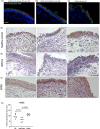ACE2 expression is elevated in airway epithelial cells from older and male healthy individuals but reduced in asthma
- PMID: 33455043
- PMCID: PMC8014151
- DOI: 10.1111/resp.14003
ACE2 expression is elevated in airway epithelial cells from older and male healthy individuals but reduced in asthma
Abstract
Background and objective: COVID-19 is complicated by acute lung injury, and death in some individuals. It is caused by SARS-CoV-2 that requires the ACE2 receptor and serine proteases to enter AEC. We determined what factors are associated with ACE2 expression particularly in patients with asthma and COPD.
Methods: We obtained lower AEC from 145 people from two independent cohorts, aged 2-89 years, Newcastle (n = 115) and Perth (n = 30), Australia. The Newcastle cohort was enriched with people with asthma (n = 37) and COPD (n = 38). Gene expression for ACE2 and other genes potentially associated with SARS-CoV-2 cell entry was assessed by qPCR, and protein expression was confirmed with immunohistochemistry on endobronchial biopsies and cultured AEC.
Results: Increased gene expression of ACE2 was associated with older age (P = 0.03) and male sex (P = 0.03), but not with pack-years smoked. When we compared gene expression between adults with asthma, COPD and healthy controls, mean ACE2 expression was lower in asthma patients (P = 0.01). Gene expression of furin, a protease that facilitates viral endocytosis, was also lower in patients with asthma (P = 0.02), while ADAM-17, a disintegrin that cleaves ACE2 from the surface, was increased (P = 0.02). ACE2 protein expression was also reduced in endobronchial biopsies from asthma patients.
Conclusion: Increased ACE2 expression occurs in older people and males. Asthma patients have reduced expression. Altered ACE2 expression in the lower airway may be an important factor in virus tropism and may in part explain susceptibility factors and why asthma patients are not over-represented in those with COVID-19 complications.
Keywords: COVID-19; SARS-CoV-2; bronchial asthma; chronic obstructive pulmonary disease; coronavirus disease; pandemic; viral infections.
© 2021 Asian Pacific Society of Respirology.
Figures




Comment in
-
Gateway to the lungs: Viral entry receptors and susceptibility to COVID-19.Respirology. 2021 May;26(5):404-405. doi: 10.1111/resp.14039. Epub 2021 Mar 16. Respirology. 2021. PMID: 33728718 Free PMC article.
References
Publication types
MeSH terms
Substances
Grants and funding
LinkOut - more resources
Full Text Sources
Other Literature Sources
Medical
Miscellaneous

